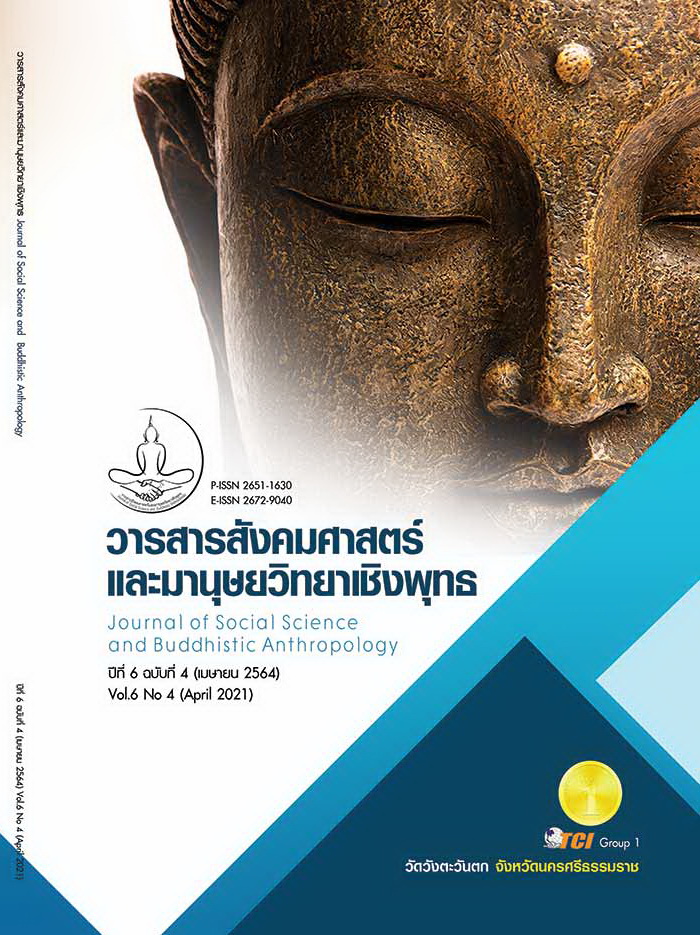Management Strategy Implementation in a New Normal Model
Keywords:
strategy, management, model, new normalAbstract
This research paper had the objectives to study 1) the management strategy implementation in a new normal model 2) to approach the management strategy implementation in a new normal model. This research was a qualitative research. The key informants were the executives in public and private sectors; the businesses Industry consultant and employees totaling 12 key informants by a purposive random sampling. The research instruments were structured interview, data collected by in-depth interview, and data analysis by using a descriptive analysis. The results showed that 1) the strategy of vision, leadership that the leaders had a clear vision and be ready to firmly cope with changes. 2) the change management strategy by creating emotional strength into a driving force for efficiency productivity. 3) the competitive advantage strategy by using the abundance of Thailand as an opportunity and an additional factor for the management to create an advantage in forecasting the future 4) the strategy to create happiness at work, the management able to create a balance and happiness to make employees confident. 5) the strategy to maintain competitiveness, the executives were able to cope with the abrupt digital transformation and create a competitive advantage 6) value creation strategy, the executives created value for products and services in order to reach and build trust of consumers.
References
กรุงเทพธุรกิจออนไลน์. (2563). ‘New Normal’ คืออะไร? เมื่อโควิด-19 ผลักเราสู่ชีวิต 'ปกติวิถี ใหม่'!. เรียก
ใช้เมื่อ 1 กุมภาพันธ์ 2564 จาก www.bangkokbiznews.com/news/detail/882508.
เกรียงศักดิ์ เจริญวงศ์ศักดิ์. (2546). การคิดเชิงกลยุทธ์. กรุงเทพมหานคร: ซัคเซสมีเดีย.
ขนิญร์นัสท์ อินทุลักษณ์. (2557). การสร้างสมดุลชีวิตกับงานของพยาบาลวิชาชีพโรงพยาบาลเอกชนแห่งหนึ่ง. วารสารพยาบาลทหารบก, 15(3), 382-388.
ถิตรัตน์ พิมพาภรณ์. (2561). กลยุทธ์การจัดการความสุขในการทำงานขององค์การ: ปัจจัยเชิงสาเหตุและ ผลลัพธ์. ใน ดุษฎีนิพนธ์ปรัชญาดุษฎีบัณฑิต สาขาวิชาการจัดการ. มหาวิทยาลัยศิลปากร.
ธงชัย ทองมา. (2558). การบริหารจัดการความเสี่ยงกับการบริหารการเปลี่ยนแปลง: องค์การในยุค โลกาภิวัตน์. ใน ดุษฎีนิพนธ์ปรัชญาดุษฎีบัณฑิต สาขาวิชาการจัดการ. มหาวิทยาลัยศิลปากร.
ธรรมทัช ทองอร่าม. (2563). New Normal ธุรกิจเตรียม “ตั้งการ์ด”. กรุงเทพมหานคร: ศูนย์วิเคราะห์ เศรษฐกิจ ทีเอ็มบี.
บุญเรือน ทองทิพย์. (2563). โรคติดเชื้อไวรัสโคโรนา 2019 (COVID-19) กับศักยภาพของผู้นำต่อการพัฒนา องค์การแบบ New Normal. วารสารสังคมศาสตร์และมานุษยวิทยาเชิงพุทธ, 5(1), 434-446.
พุทธพร อักษรไพโรจน์. (2559). กลยุทธ์การเพิ่มขีดความสามารถในการแข่งขันของธุรกิจสปาในโรงแรมและ
รีสอร์ท จังหวัดภูเก็ต เพื่อรองรับประชาคมเศรษฐกิจอาเซียน. ใน ดุษฎีนิพนธ์ปรัชญาดุษฎีบัณฑิต สาขาวิชาการจัดการการท่องเที่ยว. มหาวิทยาลัยพะเยา.
ศูนย์วิจัย Krungthai COMPASS. (2564). กรุงไทย คาดโควิดระลอกใหม่ทุบท่องเที่ยวในประเทศสูญกว่า 1.1 แสนล้าน. เรียกใช้เมื่อ1 กุมภาพันธ์ 2564. จาก www.prachachat.net/finance/news-596709.
สุธา พงศ์ถาวรภิญโญ. (2562). กลยุทธ์การสร้างสรรค์คุณค่าร่วมที่ส่งผลต่อความผูกพันของลูกค้าในโรงแรม ระดับ 3 ดาว เมืองพัทยา. ใน ดุษฎีนิพนธ์ปรัชญาดุษฎีบัณฑิต สาขาวิชาการจัดการ. มหาวิทยาลัย ศิลปากร.
อรุณกมล ศุขเอนก. (2562). กลยุทธ์การบริหารจัดการของธนาคารพาณิชย์เอกชนสู่การเป็นองค์การ สมรรถนะสูง. ใน ดุษฎีนิพนธ์ปรัชญาดุษฎีบัณฑิต สาขาวิชาการจัดการ. มหาวิทยาลัยศิลปากร.
Armstrong, G. & Kotler, P. (2009). Marketing, an Introduction (9th ed.). New Jersey: Pearson Prentice Hall.
Brinca, Pedro, Joao B. Duarte and Miguel Faria-e-Castro. (2020). Measuring Sectoral Supply and Demand Shocks during COVID-19 Retrieved from https://doi.org/10.20955/wp.
2020.011.
Daalen G.V., Willemsen T.M., & Sanders K. (2006). Reducing Work-Family Conflictthrough Different Sources of Social Support. Journal of Vocational Behavior, 69.
Eisenberger, R. & others. (1986). Perceived Organizational Support, Journal of Applied Psychology, 71, 500-507.
Lawrence G. Hrebiniak. (2005). Making Strategy Work : Leading Effective Execution and Change, Pearson Education. Inc. : Wharton School Publishing.
Majdouline Mhalla. (2020). The Impact of Novel Coronavirus (Covid-19) on theGlobal Oil and Aviation Markets. Journal of Asian Scientific Research, 10(2), 96-104.
McKinsey. (2014). Global Media Report 2014. Retrieved from http://www.mckinsey.com /client_service/media_and_entertainment/latest_thinking/global_media_report_2014.
Miles, M. B., & Huberman, A. M. (1987). Qualitative Data Analysis: A Sourcebook of New Methods. Beverly Hills, CA: Sage.
M. K. Agarwal and V. R. Rao. (1996). An Empirical Comparison of Consumer-Based Measures of Brand Equity, Marketing Letters, 7(3), 237-247.
Porter, Michael E., (1980). Competitive Strategic Technique for Analyzing. Industrial and Competitors. The Five Force. Free Press. New York.
Robbins and DeCenzo. (2004). Fundamentals of Management Essential Concept and Applications. 4th ed. Upper Saddle River. N. J: Pearson.








